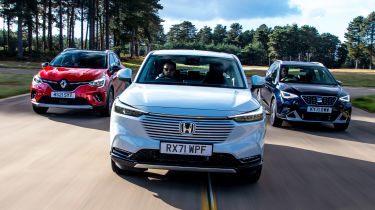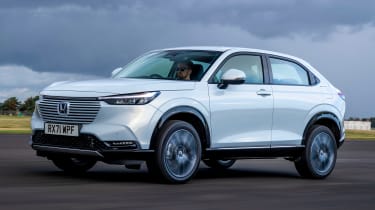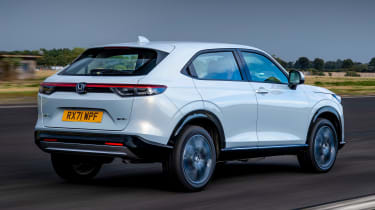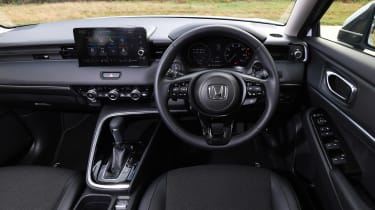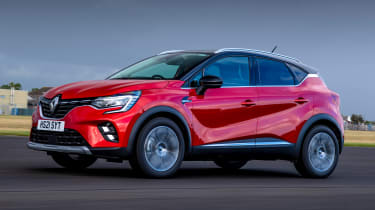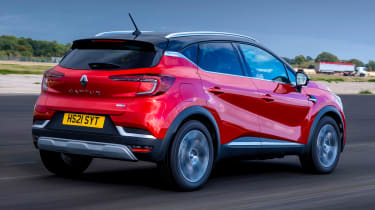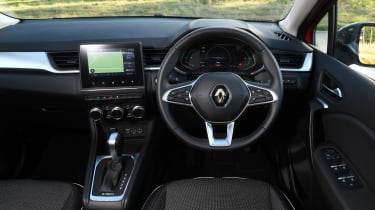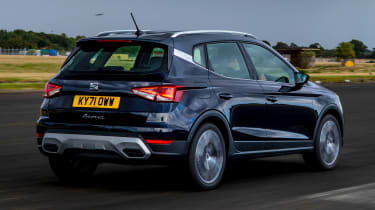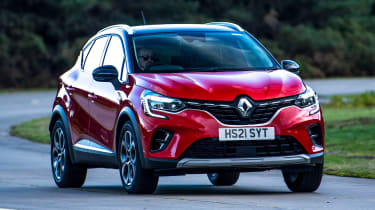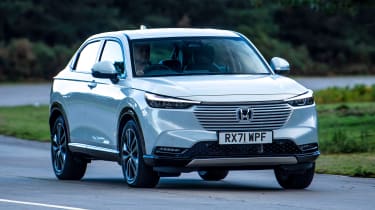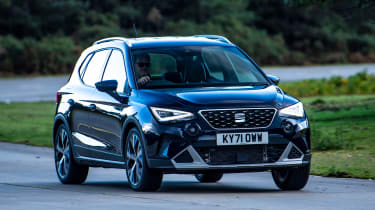Honda HR-V vs Renault Captur vs SEAT Arona: 2021 group test review
The all-new Honda HR-V uses fuel-saving hybrid tech to boost its appeal. We test it against the Renault Captur and SEAT Arona
The silent revolution of the electric car is upon us, and in many ways, EVs have moved the game on. They’re often quieter, smoother and quicker than combustion-powered alternatives. But for some buyers, there are genuine reasons not to take the plunge yet – be it range, charging availability or most crucially, price.
There is a compromise, though. Hybrids mix the refinement of electric cars with the flexibility of a combustion engine without the need for a plug, and one of the latest arrivals is the all-new Honda HR-V. The previous generation majored on practicality, but lagged behind for fuel efficiency, so will this new model be able to raise its game?
Renault has hedged its bets with electrification, pushing out a line-up filled with everything from EVs to this Captur E-Tech hybrid. The Renault and Honda both promise impressive fuel consumption – but which makes the most sense once the sums are added up?
The hybrid pair come up against the newly revised SEAT Arona. While it doesn’t have hybrid power, it has a cost advantage; once options are factored in, the top-spec model we’re testing is the cheapest car here.
Honda HR-V
| Model: | Honda HR-V e:HEV Advance |
| Price: | £29,210 |
| Engine: | 1.5-litre 4cyl hybrid, 129bhp |
| 0-62mph: | 10.6 seconds |
| Test economy: | 55.1mpg/12.1mpl |
| CO2: | 137g/km |
| Annual road tax: | £145 |
Of the three trim levels available for the HR-V, this mid-spec Advance model is expected to account for more than 60 per cent of UK sales. Including the optional Premium Sunlight White Pearl paint (£550 extra) the HR-V here is priced at £29,760, making it the most expensive car of this group.
Used - available now

2026 Porsche
Macan
18,900 milesAutomaticPetrol2.0L
Cash £47,000
2023 Jaguar
E-PACE
23,959 milesAutomaticDiesel2.0L
Cash £31,250
2021 Ford
EcoSport
12,435 milesManualPetrol1.0L
Cash £13,902
2022 Ford
EcoSport
20,987 milesManualPetrol1.0L
Cash £12,813Design & engineering
Various manufacturers have taken different approaches to hybrid technology, but Honda – unsurprisingly – believes its way is the best. The company does make some quite convincing arguments, though; the system is related to the one used by the Jazz, but a more compact and energy-dense battery helps lift the HR-V’s power output to 129bhp.
That figure is a rating for the electric motor itself, because in most circumstances, the 1.5-litre petrol engine acts as a generator for the electrical system. According to Honda, this set-up, where the engine is completely decoupled from the wheels, means that the petrol motor can operate at its optimum revs and use the least possible amount of fuel. Even when it is sending power to the road – under hard acceleration and at motorway speeds – it drives the wheels directly, because there’s no gearbox to create any mechanical drag. The battery is recharged both via the engine and through regenerative braking.
But Honda hasn’t just focused on the powertrain. The new body improves torsional rigidity by 15 per cent compared with its predecessor, and features some clever packaging to maximise cabin space.
Fit and finish inside the cabin are excellent – the Honda feels like the most expensive product here – and the driving position is comfortable and offers plenty of adjustment.
Driving
Nudge the drive selector into D, and the HR-V moves off in fully electric mode. The throttle is very smooth to modulate, so it’s easy to control in busy traffic. Increase the pace and those typically linear EV traits occasionally come unstuck.
Try to accelerate hard, and there’s a delay in the engine waking into life and sending its power to the wheels. It’s about as responsive as kickdown in a traditional automatic gearbox, though. The engine’s revs also rise at an unnatural rate relative to the car’s road speed, which causes a slightly unpleasant drone. However, the noise only occasionally disturbs an otherwise refined powertrain.
While the HR-V isn’t a class leader for ride or handling, Honda has managed to produce a car that ranks towards the top of the segment. The suspension is not quite as forgiving as the Renault’s, but the Honda is never harsh, even on large 18-inch alloy wheels. Through the corners, the HR-V is secure and stable. The steering is a particular highlight; it’s precise and loads up naturally as you turn into a corner, yet remains light and easy to use when parking.
Move up to motorway speeds and wind noise is well isolated from the cabin, although there’s an appreciable rumble coming from the tyres, particularly the rears.
Practicality
Honda’s packaging for the HR-V is unusual. While most rivals position the fuel tank below the rear seats, it’s under the fronts here, which allows Honda to keep its “Magic Seats” arrangement in the back. This means the rear bench squab can be folded vertically against the seat back, creating a space to take taller items. Those seats also fold flat, creating a completely level load area.
When you’re carrying people, the seats offer plenty of space. Rear knee room is the best here, and headroom is roughly the same as occupants will find in the Captur. As a result of the fuel tank’s position, the floor slopes gently upwards beneath the front seats, but it feels like a pleasant angle to rest your feet.
Despite some very clever touches, there are flaws. Some buyers with younger passengers might not appreciate the high-mounted door handles hidden within the C-pillars, and those who need to carry three across the back bench will find a centre seat that is the worst here; the narrow squab is very high.
At 335 litres, the Honda’s boot is marginally larger than the Captur’s 326-litre space in five-seat mode, but is down on the Arona’s 400 litres.
Ownership
While the HR-V has yet to be tested by Euro NCAP, the car’s stiffer structure and increased levels of driver assistance should see it return a strong score. For this generation, Honda has introduced an enhanced HD camera and high-speed image processing hardware to boost pedestrian-detection systems, and updated adaptive cruise control software.
Both the Arona and Captur scored the maximum five-star NCAP ratings when they were assessed – the former in 2017 and the latter two years later.
Running costs
During our time with the Honda, it more than lived up to the promise of its efficiency claims. At 55.1mpg, it just pipped the Captur for fuel economy – the Renault managed 54.3 mpg – and was comfortably ahead of the conventional petrol-engined Arona, which achieved 43.5mpg. Cover 20,000 miles at today’s lofty prices, and that means the Honda will cost £2,368 to fuel. The Renault is close behind at £2,403, but the Arona marks a big step up at £2,999.
Our economy figures included quite a significant proportion of motorway driving; spend more time around town, where petrol-electric tech works at its best, and the two hybrids will likely improve on those numbers even further – we saw the Honda exceed 60mpg on some shorter trips.
Testers’ notes: “The HR-V gets what Honda calls ‘Air Curtain’ vents. They direct insulating air along the windows to keep the car cool (or warm) without creating a draught.”
Renault Captur
| Model: | Renault Captur E-Tech Hybrid S Edition |
| Price: | £26,000 |
| Engine: | 1.6-litre 4cyl hybrid, 140bhp |
| 0-62mph: | 10.6 seconds |
| Test economy: | 54.3mpg/11.9mpl |
| CO2: | 122g/km |
| Annual road tax: | £145 |
It was our Small SUV of the Year for the second year running at our New Car Awards in 2021, but the Captur will certainly face a stern test against the new HR-V here. We’re testing the S Edition, which is priced at £26,000, while the addition of this car’s optional Flame Red paint lifts that figure to £26,700.
Design & engineering
At first glance, the Captur’s design appears fairly conventional. It rides on the same CMF-B platform as the current Clio and Nissan Juke, it’s grown 106mm longer than its predecessor, and from the outside it’s taken an evolutionary step forward from the original Captur.
Under the skin, however, this E-Tech version comes with a hybrid set-up that even exceeds the Honda’s for complexity. The system is closely related to the plug-in hybrid variant, with a 1.6-litre engine and a pair of electric motors, but here they draw energy from a smaller 1.2kWh battery.
The gearbox is Renault’s party piece. Dubbed “multi-mode”, the clutchless system drives the petrol unit with four gears, and one of the electric motors with another two, giving up to 15 possible combinations on the road to optimise efficiency in any situation.
The second electric motor is smaller and operates as a starter-generator unit, which takes care of harvesting waste energy under deceleration. The overall result is an output of 140bhp – 11bhp more than the Honda – and 250Nm of torque, which is 3Nm less. Renault states that the Captur can cover up to 80 per cent of urban drives in electric mode at up to 40mph (although the car can coast with its engine off above that).
Back to the bits you can see, and the Renault’s interior still impresses for quality when compared with its rivals. The driving position feels quite high for a relatively compact car – it’s one of the main reasons why buyers go for small SUVs such as this in the first place – and gives a decent view of the road ahead. It’s fairly easy to find a comfortable driving position, too, but the Honda’s steering wheel has a wider range of adjustment.
Driving
All of that hybrid tech might be tricky to fathom, but in practice it’s very easy to use. At low speeds, the drivetrain’s smooth, near-silent operation makes the Renault very relaxing around town, and when you need a little extra go, the throttle feels more responsive than the Honda’s.
A subtle jolt can sometimes be felt when the engine kicks in, but that’s in comparison with the seamless HR-V. Under hard acceleration, the Renault’s powertrain picks up more enthusiastically, although as with the Honda, the noises from the petrol unit sound a little unnatural when compared with the car’s acceleration.
With the Captur, Renault’s engineers have struck a neat balance between ride comfort and handling. The fairly forgiving suspension set-up feels the most comfortable here around town, while the gentle body roll helps the drive to move along with a pleasing flow on a twisty road. The steering isn’t the sharpest, but its weighting is predictable, while remaining light enough at low speeds.
Practicality
The Captur stands out with its sliding rear bench. While the boot is the smallest here when it’s set all the way back, slide it fully forward and the Captur has 440 litres of space. However, in this layout, rear legroom is cramped, so for the most part it’s best to leave it towards the back, where passengers can enjoy roughly 25mm more knee room than in the SEAT. However, the Arona offers a little more headroom than the Renault.
Like the HR-V, the Captur focuses on the comfort of the outer rear passengers rather than the occasional middle-seat user. The two main seats are the most comfortable here – there’s even some soft padding on the armrests in contrast to the Arona’s hard plastic. The central seat is a little narrow; it’s better than the Honda’s, but a little narrower than the SEAT’s.
Elsewhere, the Renault’s storage is fine. There’s a deep central bin between the seats, big cup-holders and deep door pockets. The floating centre console puts the gear shifter close to hand, and it sits ahead of a smartphone shelf with two USB ports – although not the more modern USB-C type found in the Arona.
Renault and SEAT have chosen to measure their seats-down boot volumes differently; the French brand measures to the roof, while SEAT measures to the window line. Honda has quoted figures for both, and wins either way; the HR-V has a window-line volume of 987 litres to the Arona’s 823 litres, and 1,305 litres to the roof compared with the Captur’s 1,149.
Ownership
Unlike some rivals, Renault doesn’t scrimp on safety tech, even on lower-spec models. Cruise control, lane-departure warning and lane assist are standard throughout, as are traffic-sign recognition and full LED headlights. The only thing you will need to climb the range for are front parking sensors and a rear camera; these features are standard on the S Edition and above.
Running costs
Depreciation is always an important consideration for private buyers. In this regard, the Renault splits its rivals. The E-Tech hybrid in S Edition trim is predicted to hold half of its value after three years and 36,000 miles, so this £26,000 car will be worth £13,000 after that time.
The Honda costs more to buy, but it also clings on to its value very well, at around 59 per cent, so it loses just under £12,000 of its value over the same period. The Arona is expected to hold on to 44.5 per cent of its original price, so buyers will lose £14,579 across the three-year stretch.
Testers’ notes: “The Captur’s safety tech tells the driver the proximity of the car ahead in seconds. Whatever your speed, it’s easy to maintain a safe distance.”
SEAT Arona
| Model: | SEAT Arona 1.0 TSI DSG Xperience Lux |
| Price: | £26,255 |
| Engine: | 1.0-litre 3cyl turbo, 108bhp |
| 0-62mph: | 10.8 seconds |
| Test economy: | 43.5mpg/9.6mpl |
| CO2: | 112g/km |
| Annual road tax: | £155 |
As the only-non hybrid on test, it’s possible to aim for the highest-spec SEAT Arona and still maintain a competitive price when compared with its rivals here. With metallic paint a no-cost option, the car you see here is priced at exactly the standard retail price of £26,255.
Design & engineering
A mid-life refresh for 2021 has introduced cosmetic and tech upgrades for the Arona. From the front, the model features new hot-stamped grille inserts, which look more intricate than those previously featured, while a revised bumper gives a more rugged look, and LED lighting is now standard throughout the range.
At the back, there’s a subtly reprofiled bumper and spoiler, plus the new Arona font on the bootlid. Three new exterior colours (one of which is the Asphalt Blue in these images) and a choice of 17 and 18-inch alloy wheels round out the changes.
The bigger updates happen inside. The dashboard design is all-new to accommodate a larger touchscreen infotainment set-up, which moves the air vents to a lower position. The outer vents glow as part of the ambient lighting pack, but oddly, those in the middle don’t. The lighting itself also snaps off and on when the indicators are used at night, which is quite distracting.
While the overall layout is neat enough, compared with two of the best-appointed small crossovers in the segment, the Arona’s cabin feels the cheapest here, with plenty of hard and scratchy plastics, even in many of the places you might frequently touch. On the plus side, the driving position offers a wide range of adjustment, and overall visibility is the best of this trio.
The engine line-up is petrol only, and there’s no hint of hybrid tech in sight. The 1.0-litre petrol unit is available with 94bhp and 175Nm, or 108bhp and 200Nm – the latter of which is paired with a seven-speed dual clutch DSG automatic gearbox.
There’s also a more powerful engine option with the 1.5 TSI. While not quite transforming the Arona into a hot crossover, its 148bhp output and 250Nm of torque result in a 0-62mph time of 8.4 seconds, representing lively performance for a small SUV.
Driving
You only have to travel a few yards in the Arona to discover a key – and irritating – trait. The DSG gearbox engages very abruptly (particularly in reverse) so shuffling along in heavy traffic or squeezing into a tight parking spot becomes a jerky and clumsy process. In this regard it’s average at best compared with traditional automatic rivals; beside these two hybrids – which are incredibly easy to modulate at low speeds – it feels decidedly old-fashioned.
Fortunately, things improve the faster you go. That gearbox shifts smoothly once you’re up to speed, and it’s matched to an engine which remains fairly muted even under hard acceleration. Put your foot down, and it lacks the immediate torquey response of the other two, but against the clock, its 10.8-second 0-62mph time is only 0.2 seconds behind its rivals.
The Arona’s ride is the firmest here, and road noise is a little more audible than in the Captur, too, although the SEAT is still a decent long-distance cruiser for its size. The firm ride doesn’t really translate into sporty handling. There’s little to complain about when it comes to the stable, reassuring way the car corners, though, and light steering makes it very easy to place around town. It’s just a shame that the gearbox lets things down.
Practicality
Free of the need to cram in a lot of bulky hybrid powertrain tech, the Arona is able to deliver the most spacious boot here. The 400-litre volume is ahead of both of its rivals’, and its opening is significantly lower than the Captur’s, which makes it easier to lift heavier items over the sill.
In addition to the four tethering points and two curry hooks in the back, there’s also an adjustable floor, which allows for either a deep space when the seats are up, or an almost completely flat area when the back seats are folded down.
For back-seat passengers, the SEAT offers just a touch more headroom than the Honda, but lags behind for knee room by roughly 100mm. The central hump running along the floor is the largest here, so three in the back is a bit of a squeeze. That’s a shame, because the centre seat itself is wide and flat.
The rest of the interior storage is well thought out. The wireless smartphone charging pad is sloped forward so your device stays in place while driving, and the roomy door bins can each hold a large bottle. The glovebox is a decent size, but the centre bin between the front seats isn’t as spacious as similar cubbies in the Honda or the Renault.
Ownership
The results of the annual Auto Express Driver Power satisfaction survey give a strong indication about what to expect from living with a new car. While the SEAT brand as a whole doesn’t score well for its range – a 15th-place ranking is just below the halfway mark – its dealers score extremely highly, with a fifth-place finish overall. Honda’s dealers finish just behind in eighth, but as a brand it scores much better, with an excellent sixth. Renault disappoints in both categories, however; its range overall finishes in 20th, and its dealers 22nd.
Running costs
SEAT currently offers a couple of tempting deals for those trying to sniff out a sweeter Arona. If you arrange for a test drive before buying, you will be offered a further £500 discount on the asking price, while the first two years’ worth of services will be thrown in for an additional £199. That’s down from the usual £414, and it undercuts the Renault’s £499 for three services, and £699 for the Honda’s three check-ups.
Testers’ notes: “Like those new round front spotlights? Well you’ll have to pay for the privilege; they’re only fitted to the top-spec Xperience Lux trim we have here.”
Verdict
First place: Renault Captur
While it’s run close by two very capable rivals, the Renault Captur proves once again why it’s our favourite compact crossover. Judge it on the way it drives, the space inside and the on-board tech, and at the very least it has the measure of the HR-V and Arona. On a representative finance deal, the Captur still remains the bargain of the class, and without any glaring weaknesses, it takes the win.
Second place: Honda HR-V
The third-generation HR-V is Honda’s most convincing version yet. The hybrid tech is well integrated and even more frugal than the Renault’s system, the Honda drives smartly and the cabin feels as well finished as it is versatile. However, it doesn’t blow the Renault away in any one area – and loses out in others – which makes the much greater cost difficult to justify.
Third place: SEAT Arona
Without any fuel-saving hybrid tech, the Arona is thirstier than its rivals here, and in this particular trim level it’s tough to recommend. The SEAT also isn’t as comfortable to drive, and the cabin feels like a step down in quality when compared with the Renault’s and Honda’s. However, aim for a more modest trim level and the low monthly payments will help to compensate for these downsides.
Other options for similar money...
New: Toyota Yaris Cross
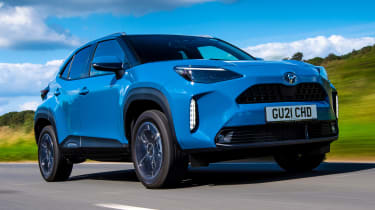
- Model: Toyota Yaris Cross Dynamic
- Price: £26,465
- Engine: 1.5l 4cyl hybrid, 114bhp
Honda isn’t the only Japanese brand that specialises in hybrid tech. The Yaris Cross boasts a set-up that achieved 56.1mpg in our hands. It’s fun to drive, too, although not as practical as the Renault or Honda. There’s even a four-wheel-drive option.
Used: MINI Countryman

- Model: Mini Countryman Cooper SE (’19)
- Price: £27,000
- Engine: 1.5l 3cyl PHEV, 221bhp
Dip into the used market, and you can bag a premium SUV with even greater electric potential. The Countryman PHEV has a 7.6kWh battery, good for roughly 20 miles of electric driving, and with 221bhp, it has the legs on the competition here.
Figures
| Renault Captur E-Tech Hybrid S Edition | Honda HR-V e:HEV Advance | SEAT Arona 1.0 TSI DSG Xperience Lux | |
| On the road price/total as tested | £26,000/£26,700 | £29,210/£29,760 | £26,255/£26,255 |
| Residual value (after 3yrs/36,000) | £13,000/50.0% | £17,275/59.1% | £11,676/44.5% |
| Depreciation | £13,000 | £11,935 | £14,579 |
| Annual tax liability std/higher rate | £1,340/£2,681 | £1,623/£3,246 | £1,611/£3,222 |
| Annual fuel cost (12k/20k miles) | £1,442/£2,403 | £1,421/£2,368 | £1,800/£2,999 |
| Insurance group/quote/VED | 13/£436/£145 | 31/£541/£145 | 13/£449/£155 |
| Cost of 1st/2nd/3rd service | £499 (3 years) | £699 (3 years) | £199 (2 years) |
| Length/wheelbase | 4,227/2,639mm | 4,340/2,610mm | 4,154/2,566mm |
| Height/width | 1,576/1,797mm | 1,582/1,790mm | 1,529/1,780mm |
| Engine | 4cyl in-line/1,598cc | 4 cyl in-line/1,498cc | 3cyl in-line/999cc |
| Peak power/revs | 140bhp*/N/A | 129/6,000 bhp/rpm | 108/5,500 bhp/rpm |
| Peak torque/revs | 250Nm*/N/A | 253/4,500 Nm/rpm | 200/2,000 Nm/rpm |
| Transmission | 6-spd auto/fwd | Single-spd auto/fwd | 7-spd auto/fwd |
| Fuel tank capacity/spare wheel | 39 litres/£250 | 40 litres/repair kit | 40 litres/repair kit |
| Boot capacity (seats up/down) | 326-440/1,149 litres | 335/1,305 litres | 400/823+ litres |
| Kerbweight/payload/towing weight | 1,472/424/750kg | 1,380/490kg/N/A | 1,233/507/1,200kg |
| Turning circle | 11.1 metres | 11.3 metres | 10.6 metres |
| Basic warranty (miles)/recovery | 5yrs (100,000)/3yrs | 3yrs (90,000)/3yrs | 3yrs (60,000)/2yrs |
| Driver Power manufacturer/dealer pos | 20th/22nd | 6th/8th | 15th/5th |
| NCAP: Adult/child/ped./assist/stars | 96/83/75/74/5 (’19) | N/A | 95/80/77/60/5 (’17) |
| 0-62mph/top speed | 10.6 secs/106mph | 10.6 secs/106mph | 10.8 secs/118mph |
| Auto Express economy/range | 54.3/12.1/466 miles | 55.1/11.9/485 miles | 43.5/9.6/383 miles |
| WLTP combined | 57.6mpg | 52.3mpg | 46.7mpg |
| WLTP combined | 12.7mpl | 11.5mpl | 10.3mpl |
| Actual/claimed CO2/tax bracket | 120/112g/km/26% | 118/122g/km/28% | 150/137g/km/31% |
| Airbags/Isofix/park sensors/camera | Six/yes/F&R/yes | Six/yes/F&R/yes | Six/yes/F&R/yes |
| Auto box/lane keep/blindspot/AEB | Yes/yes/no/yes | Yes/yes/yes/yes | Yes/yes/yes/yes |
| Climate control/cruise control | Yes/yes | Yes/yes | Yes/yes |
| Leather/heated seats | No/yes | Part/yes | No/yes |
| Metallic paint/LED lights | £600/yes | £550/yes | £0/yes |
| Keyless entry & go/power tailgate | Yes/no | Yes/yes | Yes/no |
| Sat-nav/digital dash | Yes/yes | Yes/yes | Yes/yes |
| DAB radio/connected services | Yes/yes | Yes/yes | Yes/yes |
| Wireless charge/CarPlay/Android Auto | DFO/yes/yes | No/yes/yes | Yes/yes/yes |
